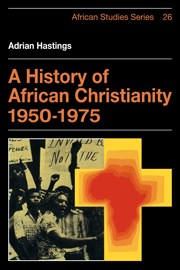5 - Between politics and prayer
Published online by Cambridge University Press: 28 October 2009
Summary
Twenty-six years form a fairly short space of time in institutional history and when that span is as close to us as is that which we have been considering, it is bound to be somewhat tricky to discern and assess the more truly significant shifts in the character of communities. Some of the communities we have been studying did not even exist at the beginning of the period and many others have unquestionably altered profoundly. There were indeed areas of some ecclesiastical stability existent in 1950 – the main Protestant churches close to the English-speaking west coast from Sierra Leone to Calabar, Anglicans and Methodists in the Cape, Catholics in Masaka or Ufipa – in such places change could be relatively slight in the following quarter century, but the overall picture is very different. Quantitatively the African Christian community advanced from something in the range of 25 million to one towards 100 million; geographically its spread grew, particularly into the sudanic belt, and its balance altered away from the far south; the number of separate denominations and churches greatly increased, so did the structures within existing churches and the relations between them. Beneath all this there were shifts in concern, in religious language, in almost everything.
The 1950s, the Indian summer of colonialism, were also the last decade in which the missionary movement publicly called the tune within Africa's ecclesiastical scene.
- Type
- Chapter
- Information
- A History of African Christianity 1950–1975 , pp. 258 - 274Publisher: Cambridge University PressPrint publication year: 1979

